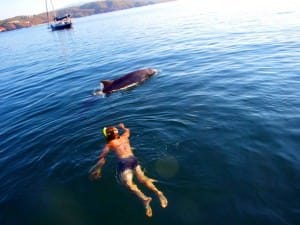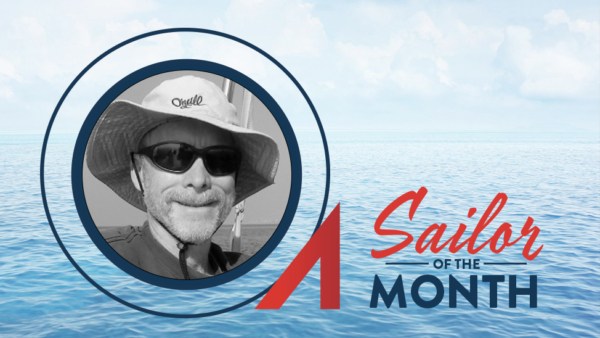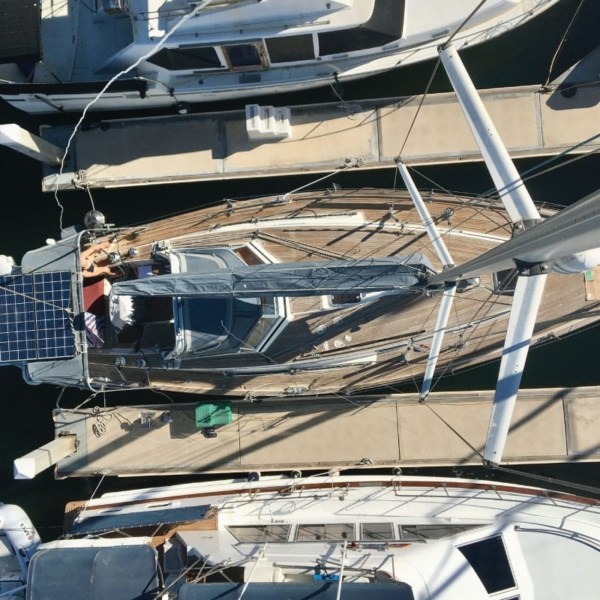 In this special edition of Voyaging with Velella, ASA writer-at-large Meghan Cleary answers a popular question from readers: What is the necessary budget for living aboard and cruising in a sailboat? Meghan and her fiance Prescott are currently on a 9-month cruise in the tropics aboard S/V Velella.
In this special edition of Voyaging with Velella, ASA writer-at-large Meghan Cleary answers a popular question from readers: What is the necessary budget for living aboard and cruising in a sailboat? Meghan and her fiance Prescott are currently on a 9-month cruise in the tropics aboard S/V Velella.
A number of people have asked me lately what it costs to go cruising. The answer to that question is as widely variable as what it costs people to live on land, because there is a wide range of different lifestyles even within the cruising circuit. But if you have tons of cash, you probably aren’t as keen to understand the breakdown of costs as someone attempting to do this on a shoestring. So the important question is, what is the minimum budget required to cruise? If you have more than that to work with, great! More cervezas for you.
Perhaps it is because we are young cruisers ourselves, the exception to the norm in this community, that I’m always interested to know how the other young cruisers make ends meet. If you’re cruising for retirement, it’s understood that you’ve spent your life saving up for exactly this, and while you want to be frugal to stretch it as far as it can go, you’re drawing from a relatively deep well. Young cruisers on the other hand, most often have a much more limited budget, and therefore a limited timeframe in which to cruise. We always ask young people, “So, are you working from the boat? Where’s the cashflow coming from for you?” Invariably the answer is either that they’ve found a way to make some money while cruising (like Prescott, who continues to freelance as a motion graphics artist); or they’re just sailing for the season and planning to head home to work in 6 months or so.
If your dream is to buy a boat and sail away forever to distant shores on no timeline whatsoever, of course you’re going to need to save up for a loooong time. But if you can be flexible about your cruising, it’s possible to get underway on a much smaller annual budget.

Carrying A House on Your Back
The first critical stage in financial planning for a cruise is obviously to acquire the boat itself, along with all the gear needed to outfit it. Depending on the boat you buy and what it comes with, you could spend as little as a few thousand dollars or double the cost of the boat to outfit it properly. Outfitting costs cover an enormous range, and are largely impacted by the gear choices you make. With Velella, we placed a lot of importance on making her as safe as possible. That included purchasing an offshore life raft, an EPIRB, hydrostatic PFDs, good jack lines and tethers, an SSB radio to be able to receive up-to-date weather information underway, and even a Monitor self-steering vane to alleviate the exhausting prospect of hand steering 24/7. We’ve got our trusty whisker pole from Forespar (pictured at right). We carry a full complement of engine and rigging spares onboard, as well as all necessary tools to ensure we’re as self-sufficient as possible should any sort of problem strike. However, if you plan to live aboard, even the cost of buying and outfitting a very nice boat can be far less expensive than owning a house on land!
Excluding the cost of the boat itself (our home mortgage), we spent roughly 2/3 of our total cruising budget on outfitting. We left Los Angeles this year with a plan to sail for 6-9 months and $7,000 in our pockets. That money was divvyed up into the following categories on a monthly budget:
Moorage: $100 per month
Fuel and Other Transportation: $120 per month
Boat Maintenance Expenses: $100 per month
Food $300 per month
Discretionary/Entertainment $50 each per month
Customs and Fees: $50 month average

Other expenses we had also planned for were the ongoing boat mortgage, student loans (!), boat insurance, and international medical insurance. Your boat mortgage and insurance will vary widely; international medical insurance is cheap to come by at $600 for the year covering both of us. We added up these “unseen” expenses and make sure we had enough in addition to the $7,000 we were taking with us to cover these things while we were gone.
A $700/month spending budget is remarkably tight; I would place that at the bottom end of the cost range. It’s also worthwhile to note that Central America has become a lot more expensive in recent years; moorage in most ports in Mexico, for example, costs almost double US prices.
Jumping In
If you’re serious about saving up to go cruising, there are a number of excellent, in-depth resources you should consult, first and foremost being “The Voyager’s Handbook” by Beth Leonard. Meanwhile, here are a few planning pointers you can take away from our experience preparing ourselves and Velella to go cruising:
1. PLUG IN TO THE SAILING COMMUNITY EARLY. Cruising sailors are all on a budget, and the community is constantly swapping gear when they’re through using it. You’d be shocked at how much money we saved on gear just by checking first if anyone knew of someone getting rid of an outboard, a drogue, a spinnaker sail, whatever!
2. BE REALISTIC ABOUT YOUR NEEDS. Use other people’s budgets as models, but weight your own needs in there too. You can learn to live without many things, and you will, but certain things you just won’t be able to give up; know yourself and be realistic about what those are when putting together your budget.
3. SET YOURSELF A TIME LIMIT FOR SAVING. THEN GO, GO WITHOUT, AND THEN GO HOME. We would have liked to set out with more money on this trip; our budget is extremely tight. Spending only $50 a month for fun is HARD—try it sometime! Last month my sole purchase was a cruising guide to the Sea of Cortez. . . which I read and reread and reread for a month. And this week we’re having culinary adventures trying to stretch our last $20 to cover a week’s worth of food. But don’t let a lack of extra spending money stop you from sailing away—it’s absolutely amazing and gratifying to live so simply, and plus, there are incredible tropical reefs and hikes and other natural diversions to keep you plenty occupied for free while cruising. When the money runs out, then be willing to go home and work some more to top off the cruising kitty.
4. BE PREPARED TO PUT MONEY TOWARDS IMPROVING YOUR OWN SEAMANSHIP SKILLS. The best piece of gear we have onboard is our know-how. One of the most valuable preparations we did before leaving Seattle was to hire an ASA instructor for a week-long Advanced Offshore Cruising certification course on our own boat (from the wonderful San Juan Sailing School in Bellingham, WA). All of the skills you can develop in advance will make you more confident sailing through heavy seas or pressing on overnight, anchoring in tight spaces instead of paying to moor, and fixing problems you’d otherwise have to pay someone else to help you with.
Don’t listen to people who say you have to take 5 or 10 years to get underway. Just be practical about your plans and commit to them! If you have a burning wanderlust in you, you can devise a way to follow this dream. And give me a holler when you’re ready to meet up in an anchorage somewhere warm!
Here’s where the crew of Velella is living the good life on a shoestring budget right now:
View Voyaging with Velella in a larger map











